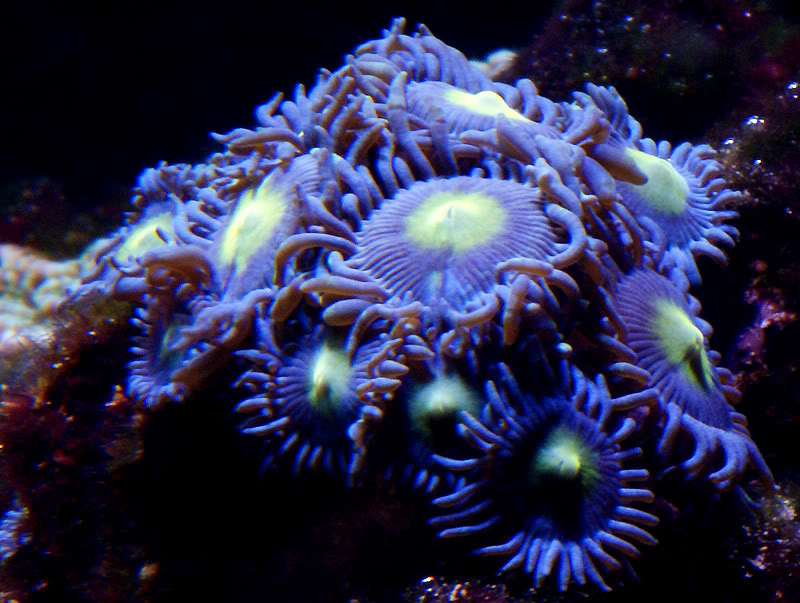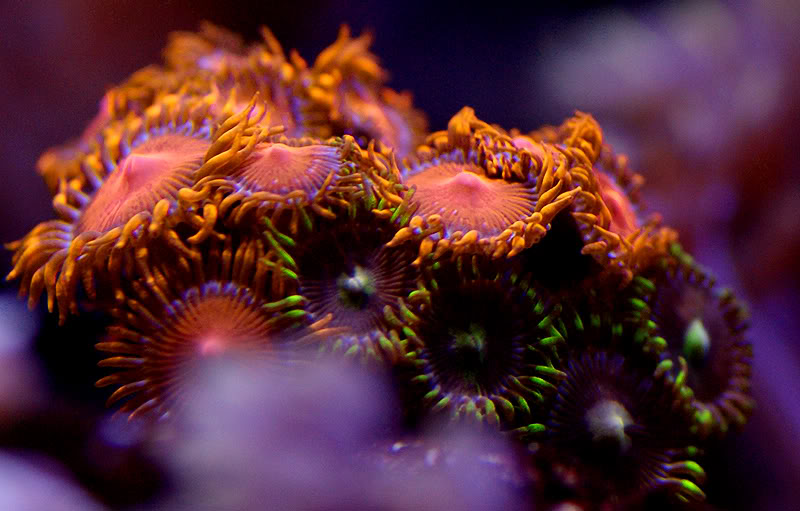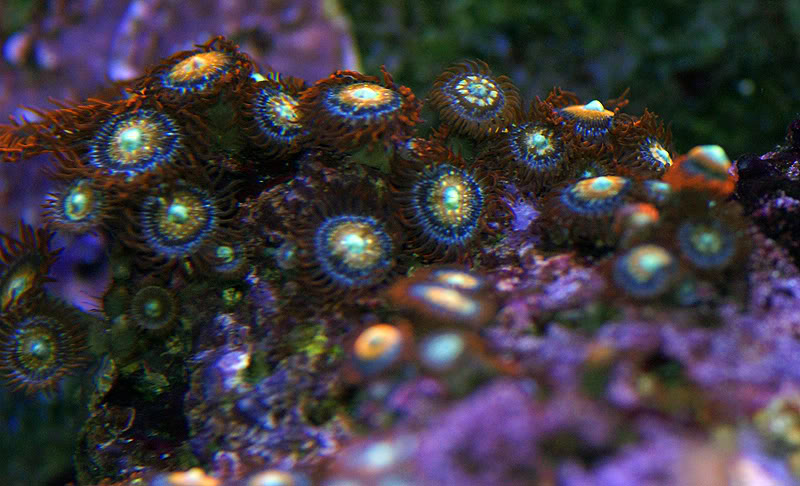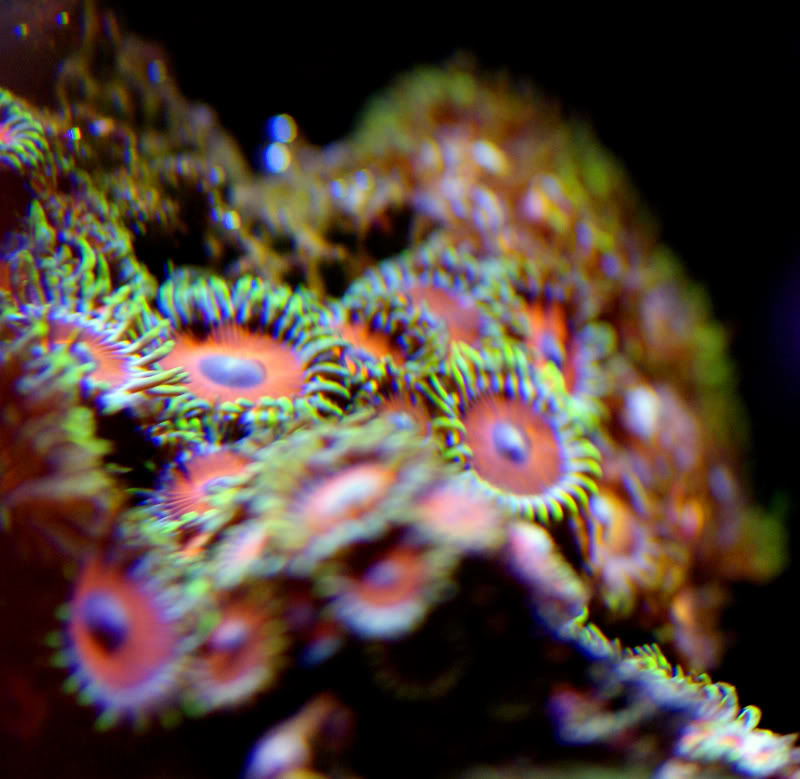Seriously!
I have been keeping zoas/palys for a long time. 20 years ago these were only known as button polyps and the majority were from the Caribbean as they came on what was then called Atlantic Shelf rock. This live rock was very large shelf like pieces that was extremely porous and light. They were usually covered in Eagle Eye type zoas. Because water parameters 20 years ago were a bit on the rich side, these zoas usually spread extremely fast and took over other stuff in the tank. Many considered them pest, so I was surprised at how they gained favor over the last 5 years as they are now one of the most popular corals to keep.
In the last 3 years, I have been deliberately trying to propagate zoas.(like many of you)
I have paid very close attention to what works and doesn't. One thing I have found out is that cutting the flesh of the polyp can trigger a new polyp to grow from the wound, yet this is a 50/50 event. So I kept looking and wondering why do they just explode in population sometimes and die off or stop reproducing after I frag them?
I believe I have found the answer but am not a scientist and can never validate what I have been seeing, but I will share this with all of you and see what you thoughts are. I tend to post on multiple forums redundantly for mixed opinions and to share observations, but this site is the Original Club-Zoa, so I will only post it here and link it at other sites.
I have been watching countless frags and colonies change population densities and wondered is it light, food, flow? Well yes to all 3, but that is only a natural cause as feeding, having a good ample light source, and a good flow of clean water is essential to success with all corals, but why do they sometimes explode in growth?
Here is what I think is the answer...SEXUAL REPRODUCTION.(of some sort)
Let me show you some pics as my tank is reproducing rapidly the last 2 weeks...
Pic 1, Alien Eye Zoas...

Does anyone notice anything strange or out of the ordinary? If not look to each polyp and compare.
You will see that some polyps are definitely larger.(I believe this to be a female polyp, but who am I to judge?) I call these large polyps the Mother polyps.
Now look at some of the other polyps that have their centers protruding. I believe that these are male polyps and that they are working with the female polyps to fertilize each other to produce "daughter polyps".
In every case for the last 1year this takes place and I see a rapid increase in the growth of a colony. Now here are some more pics also showing larger polyps and polyps with protruding centers....
Pic 2, Bam-Bams...

Pic 3, Unidentified zoas...

In all pics there has been rapid growth and the centers have been protruding, perhaps releasing chemicals or something I can not see that helps reproduction.
Now look at these 2 pics of very slow(or inactive) growers...
Pic 4, Unidentified zoas...

Pic 5, Whamin Watermelons...

In comparison these colonies have flat centers and are NOT protruding like the other zoas.
With that said, the zoas I have now will not be protruding next week either. I believe that after a growth explosion, they have a rest period before they become active again. I also believe that there must be a trigger that causes a colony to begin this, like a chemical release from 1 polyp or an environmental trigger like a drop in temp. This I have not been able to pinpoint.
So great, I have a theory that when my zoas are protruding they are sexually reproducing. So why do they all of a sudden die off or not regrow when I frag them and get rid of the polyps?
My guess here is that the large polyp is the Mother. If you frag the largest polyps and keep the small ones it takes for ever to get them growing again. I believe the large polyps are sexually active and therefore trigger more zoa production. Almost every time I have lost the largest polyp to a frag or trade I have had a recession in growth or I lose the colony.
This is not a lab tested theory, but my observations over the years. I an not prove anything but just show you pics and tell you what I see happening over long periods of time. I have taken zoas and fragged the large one to see what happens when I keep it on a plug with 2 protruding zoas. The result after a healing period of about 1 to 2 weeks is again an explosive growth were the colony triple in size in less than a month.
I hope you guys who are zoas diehards like me think about this and watch your tank for some of this activity. I would love to hear that you see this happening also. I have witnessed it in several different systems between here(St.louis) and Chicago, but again I am just looking and seeing this. I believe that many would not even notice, but I have been trying to figure this out. I got the idea from plants pollinating one another. It could be possible that something similar is happening here also.
What do you guys think?
I have been keeping zoas/palys for a long time. 20 years ago these were only known as button polyps and the majority were from the Caribbean as they came on what was then called Atlantic Shelf rock. This live rock was very large shelf like pieces that was extremely porous and light. They were usually covered in Eagle Eye type zoas. Because water parameters 20 years ago were a bit on the rich side, these zoas usually spread extremely fast and took over other stuff in the tank. Many considered them pest, so I was surprised at how they gained favor over the last 5 years as they are now one of the most popular corals to keep.
In the last 3 years, I have been deliberately trying to propagate zoas.(like many of you)
I have paid very close attention to what works and doesn't. One thing I have found out is that cutting the flesh of the polyp can trigger a new polyp to grow from the wound, yet this is a 50/50 event. So I kept looking and wondering why do they just explode in population sometimes and die off or stop reproducing after I frag them?
I believe I have found the answer but am not a scientist and can never validate what I have been seeing, but I will share this with all of you and see what you thoughts are. I tend to post on multiple forums redundantly for mixed opinions and to share observations, but this site is the Original Club-Zoa, so I will only post it here and link it at other sites.
I have been watching countless frags and colonies change population densities and wondered is it light, food, flow? Well yes to all 3, but that is only a natural cause as feeding, having a good ample light source, and a good flow of clean water is essential to success with all corals, but why do they sometimes explode in growth?
Here is what I think is the answer...SEXUAL REPRODUCTION.(of some sort)
Let me show you some pics as my tank is reproducing rapidly the last 2 weeks...
Pic 1, Alien Eye Zoas...

Does anyone notice anything strange or out of the ordinary? If not look to each polyp and compare.
You will see that some polyps are definitely larger.(I believe this to be a female polyp, but who am I to judge?) I call these large polyps the Mother polyps.
Now look at some of the other polyps that have their centers protruding. I believe that these are male polyps and that they are working with the female polyps to fertilize each other to produce "daughter polyps".
In every case for the last 1year this takes place and I see a rapid increase in the growth of a colony. Now here are some more pics also showing larger polyps and polyps with protruding centers....
Pic 2, Bam-Bams...

Pic 3, Unidentified zoas...

In all pics there has been rapid growth and the centers have been protruding, perhaps releasing chemicals or something I can not see that helps reproduction.
Now look at these 2 pics of very slow(or inactive) growers...
Pic 4, Unidentified zoas...

Pic 5, Whamin Watermelons...

In comparison these colonies have flat centers and are NOT protruding like the other zoas.
With that said, the zoas I have now will not be protruding next week either. I believe that after a growth explosion, they have a rest period before they become active again. I also believe that there must be a trigger that causes a colony to begin this, like a chemical release from 1 polyp or an environmental trigger like a drop in temp. This I have not been able to pinpoint.
So great, I have a theory that when my zoas are protruding they are sexually reproducing. So why do they all of a sudden die off or not regrow when I frag them and get rid of the polyps?
My guess here is that the large polyp is the Mother. If you frag the largest polyps and keep the small ones it takes for ever to get them growing again. I believe the large polyps are sexually active and therefore trigger more zoa production. Almost every time I have lost the largest polyp to a frag or trade I have had a recession in growth or I lose the colony.
This is not a lab tested theory, but my observations over the years. I an not prove anything but just show you pics and tell you what I see happening over long periods of time. I have taken zoas and fragged the large one to see what happens when I keep it on a plug with 2 protruding zoas. The result after a healing period of about 1 to 2 weeks is again an explosive growth were the colony triple in size in less than a month.
I hope you guys who are zoas diehards like me think about this and watch your tank for some of this activity. I would love to hear that you see this happening also. I have witnessed it in several different systems between here(St.louis) and Chicago, but again I am just looking and seeing this. I believe that many would not even notice, but I have been trying to figure this out. I got the idea from plants pollinating one another. It could be possible that something similar is happening here also.
What do you guys think?
Last edited:

















